All Fish All Waters – Fly Rod Spinner Baits, Spoons and Plugs
By Joseph D. Cornwall
A spinner-fly combination is, perhaps, one of the oldest American fly rod artificials. For warm water species this could actually be considered an absolute tradition. Its popularity waned after World War II with the advent of spinning gear which could cast lures too light to use with the then standard bait-casting gear. Unfortunately for fly fishers in general, the last bastion of the spinner-fly combination is in trolling for salmon and trout. Fashion flashes a fickle smile and a most productive bait is nearly lost to history. There is no scaled inhabitant of the watery deep can resist the call of a wobbling, flashing Colorado, Indiana or Willow Leaf spinner blade!
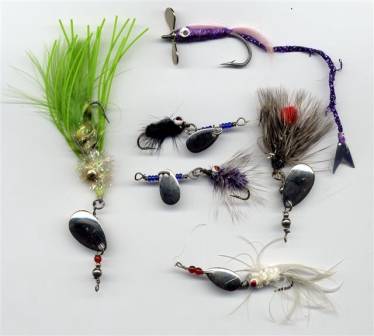 Once
upon a time nearly every hardware store, sporting goods outlet and general
store offered a fine selection of small, light-weight spinners ready made
for use with a simple fly pattern. Large,
gaudy wet flies, simple palmered patterns, or small strips of pork rind
and chamois were all favored at the business end depending on the targeted
species. Nothing in nature has changed.
A spinner-fly combination is still a deadly offering.
You may have to hunt a little harder for a commercial offering - or
even make your own- but either option is well worth the investment in
time. Spinners are incorporated into flies in several additional methods.
Beyond the aforementioned spinner-fly combinations there are
safety-pin style spinnerbait flies, tail-spinner flies and off-set spinner
flies. Let’s take a look at each in turn.
Once
upon a time nearly every hardware store, sporting goods outlet and general
store offered a fine selection of small, light-weight spinners ready made
for use with a simple fly pattern. Large,
gaudy wet flies, simple palmered patterns, or small strips of pork rind
and chamois were all favored at the business end depending on the targeted
species. Nothing in nature has changed.
A spinner-fly combination is still a deadly offering.
You may have to hunt a little harder for a commercial offering - or
even make your own- but either option is well worth the investment in
time. Spinners are incorporated into flies in several additional methods.
Beyond the aforementioned spinner-fly combinations there are
safety-pin style spinnerbait flies, tail-spinner flies and off-set spinner
flies. Let’s take a look at each in turn.
The straight shaft spinner was, at one time, a staple for use with fly fishing tackle. The late Tom Nixon, in “Fly Tying and Fly Fishing for Bass and Panfish” devoted most of a chapter to this combination and went on to revisit it in several changes of costume throughout his book. Hildebrandt still markets, after more than fifty years, a number of models appropriate to long rod use and carrying a few in your kit is cheap insurance. A few size 4 or 6 gold Aberdeen hooks with a short, white, rabbit zonker strip tied on with fluorescent red thread and two or three size 0 or size 1 straight shaft spinners fit nicely into the empty heavy plastic envelopes fly tying hooks are packaged in, weigh almost nothing, and are easy to cast on any fly rod 5 weight or heavier. You can simplify even further by carrying just the spinners and clevises with a few small beads and threading them directly onto the tippet ahead of the fly. Try it when all your favorites fail and you may find the spinner fly combo quickly becoming a new go-to.
In 1992, Andy Burke introduced his version of a spinner bait expressly designed for fly rod application. Burke’s Bass Flash, especially when tied with dumbbell eyes on a jig hook a la Deke Meyer, is an excellent choice for faster fishing in shallow water when water temps are higher and fish activity is correspondingly increased. This is an ideal choice for early to mid summer fishing in streams, rivers, lakes and ponds. Best of all, this tie can be scaled to work well with 4, 5 and 6 weight rods. While not strictly a spinner bait as it doesn’t actually utilize a spinner, its action and application are similar.
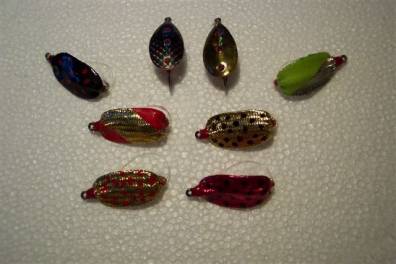 Captain
Jim Dupre popularized the spoon fly for redfish in Texas and Florida quite
some time ago. Anyone fishing
the salty coast of the Gulf of Mexico will find the pattern highly
recommended and widely available. It
is truly unfortunate that this important fly rod lure hasn’t received
greater recognition by sweet water anglers as it can be a killer!
Loosely based on the famed Johnson’s Silver Minnow, an
octogenarian fishing classic, Dupre’s Spoon Fly has spawned a host of
similar flies, all aimed primarily at subtropical flats fishing.
Like its hardware ancestors (incidentally, the Johnson’s Silver
Minnow was once widely offered in a fly rod size), the spoon fly is
extremely effective on a variety of freshwater temperate species.
From yellow perch to white bass, pike and pickerel to smallmouth
bass and crappie, no finny denizen is immune to its wiggling charms. This artificial is a close to a perfect ‘vertical drop
fly’ as any I have fished.
Captain
Jim Dupre popularized the spoon fly for redfish in Texas and Florida quite
some time ago. Anyone fishing
the salty coast of the Gulf of Mexico will find the pattern highly
recommended and widely available. It
is truly unfortunate that this important fly rod lure hasn’t received
greater recognition by sweet water anglers as it can be a killer!
Loosely based on the famed Johnson’s Silver Minnow, an
octogenarian fishing classic, Dupre’s Spoon Fly has spawned a host of
similar flies, all aimed primarily at subtropical flats fishing.
Like its hardware ancestors (incidentally, the Johnson’s Silver
Minnow was once widely offered in a fly rod size), the spoon fly is
extremely effective on a variety of freshwater temperate species.
From yellow perch to white bass, pike and pickerel to smallmouth
bass and crappie, no finny denizen is immune to its wiggling charms. This artificial is a close to a perfect ‘vertical drop
fly’ as any I have fished.
The downside to the spoon fly is its frightening air resistance. Difficult to cast can be an understatement and this handicap is bolstered by a tendency for the spoon fly to twist during casting and during the retrieve. Most folks who experienced real problems with the Dupre’s Spoon Fly and its cousins (me included) failed to match this lure to a proper leader. When using an artificial like this it is important to use as short a leader as possible coupled with very hard monofilament. Attach the spoon fly using a non-slip mono loop knot or Rapala knot for best results. An extreme forward taper line like a bass-bug taper is also helpful. I typically trim about two feet off the front taper of my bass-bug lines to further enhance their ability to turn over heavy, wind resistant baits.
Some fly rod aficionados will advise the use of a
barrel swivel with a spoon fly and with some of the patterns discussed
below. I disagree with this.
A well designed hard-mono leader will minimize any induced twist
and help increase the action of the spoon without adding additional weight
and hardware. Experiment for yourself and see what works best for you.
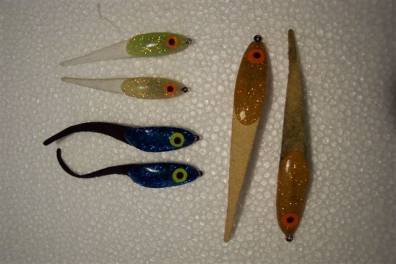 The
Spoon Minnow by Kreel Tackle Co. (http://www.kreeltackle.com/) is a
wonderfully productive variation of the Dupre’s Spoon Fly.
Made with a chamois tail and hard epoxy head, the Kreel Tackle Co.
Spoon Minnow is easier to cast than most other fly rod spoons and has a
unique action in the water. Offered
in several color combinations, my personal favorites have been
chartreuse-and-white, gold-and-gold and blue-and-black.
This is one of my most productive smallmouth bass patterns and I
almost always fish it on a 10’ sink-tip line (this fly balances nicely
with a 6 weight rod), 2 to 3 foot hard mono leader and a non-slip mono
loop knot. Again, a barrel
swivel just isn’t needed, in my opinion.
Use this fly on a long leader with a floating line, however, and
twisted tangles are almost a sure thing.
The
Spoon Minnow by Kreel Tackle Co. (http://www.kreeltackle.com/) is a
wonderfully productive variation of the Dupre’s Spoon Fly.
Made with a chamois tail and hard epoxy head, the Kreel Tackle Co.
Spoon Minnow is easier to cast than most other fly rod spoons and has a
unique action in the water. Offered
in several color combinations, my personal favorites have been
chartreuse-and-white, gold-and-gold and blue-and-black.
This is one of my most productive smallmouth bass patterns and I
almost always fish it on a 10’ sink-tip line (this fly balances nicely
with a 6 weight rod), 2 to 3 foot hard mono leader and a non-slip mono
loop knot. Again, a barrel
swivel just isn’t needed, in my opinion.
Use this fly on a long leader with a floating line, however, and
twisted tangles are almost a sure thing.
The Kreel Tackle Spoon Minnow is best cast across
stream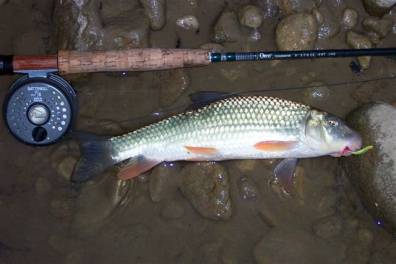 and allowed to dead-drift on a tight line.
When used this way it has an amazing wobbling action that really
mimics the fluttering of a wounded baitfish.
I have taken largemouth, smallmouth, and spotted bass along with
just about every other Midwestern game fish on this design.
In fact, the Kreel Tackle Spoon Minnow accounted for my best ever
Golden Red Horse Sucker to fall for a fly, something that amazed me at the
time. I guess I never thought
of a sucker (and the Red Horse Sucker is a beautiful fish, if using those
terms in the same sentence isn’t an oxymoron) as particularly
aggressive, but the fish I caught hit like a freight train and pulled like
an aquatic SUV!
and allowed to dead-drift on a tight line.
When used this way it has an amazing wobbling action that really
mimics the fluttering of a wounded baitfish.
I have taken largemouth, smallmouth, and spotted bass along with
just about every other Midwestern game fish on this design.
In fact, the Kreel Tackle Spoon Minnow accounted for my best ever
Golden Red Horse Sucker to fall for a fly, something that amazed me at the
time. I guess I never thought
of a sucker (and the Red Horse Sucker is a beautiful fish, if using those
terms in the same sentence isn’t an oxymoron) as particularly
aggressive, but the fish I caught hit like a freight train and pulled like
an aquatic SUV!
Turn a spoon on its side, drill a hole in the middle and you will end up with something akin to the Action Disc. Quoting from the description found at the manufacturer’s web site (http://www.fineflies.com/Trolling/actiondiscs.htm) : “Action Discs impart movement to the fly two ways. The disc moves side to side as it is drawn through the water and it creates turbulence behind the disc. The side to side movement has some interesting effects. When used with small wooly buggers the fly jumps side to side behind the disc. As we tested longer and longer flies we found that the head of the fly moved back and forth more than the tail and this put "S" turns into the materials of the fly giving the most enticing swimming motion we have ever seen. Standard hard bodied crank baits wiggle through the water but they can not swim like a soft bodied lure can. The second disc feature, turbulence created behind the disc, solved another common fault… the tendency for the fly body material to be compressed by the water flowing over it. The turbulence lifts the soft materials away from the hook shank giving them room to move.”
The Action Disc was designed as an aid for trolling- predominantly for trout and salmon if I read the advertising copy correctly – but I have found that it is useful for much more than trolling. Certainly if you are paddling your canoe or kicking your float tube from one spot to another, trailing a fly behind a Action Disc as you travel is a good way to pick up otherwise unexpected fish. In fact, I will go so far as to say that trolling flies without an Action Disc cuts their effectiveness appreciably, but that is a discussion for a different day. For me the Action Disc is a vital accessory to casting big deceivers for striped bass, wipers and other pelagic species. The light weight and small size of the Action Disc doesn’t interfere with casting too much and the tight wiggle and sonic signature of the disc adds a new dimension to big baitfish imitations.
I add a small bead between the Action Disc and the knot at the hook eye to protect the tippet from unnecessary wear. Using a size 2 Deceiver, the action disc turns the fly into a formidable crankbait. In murky, off-color water this allows game fish to key in on the fly and significantly improves the ratio of strikes to presentations. This little device is something no serious fly fisher should be without. When spin fishers casting big plugs are getting all the action, the addition of an Action Disc can even the score in short order.
Mention crank baits and I am quite confident that
almost no one will think first of a fly rod.
Once upon a time small crank baits were made expressly for fly
rods, however. The
 Heddon
Punkinseed is one model that comes immediately to mind and choice examples
of that now long discontinued plug sell in collector’s circles for
hundreds of dollars each! Other
vintage models include fly rod Heddon River Runts, Arbogast Jitterbugs and
Hula Poppers, Worden Lures Helin Flatfish and countless others.
Nearly every crankbait from the mid to early twentieth century had
its counterpart in a fly rod size. With
the advent of spinning rods after World War II, many of these fly rod
lures ceased to be. That is
unfortunate as they were, and are, quite effective when properly used.
Heddon
Punkinseed is one model that comes immediately to mind and choice examples
of that now long discontinued plug sell in collector’s circles for
hundreds of dollars each! Other
vintage models include fly rod Heddon River Runts, Arbogast Jitterbugs and
Hula Poppers, Worden Lures Helin Flatfish and countless others.
Nearly every crankbait from the mid to early twentieth century had
its counterpart in a fly rod size. With
the advent of spinning rods after World War II, many of these fly rod
lures ceased to be. That is
unfortunate as they were, and are, quite effective when properly used.
A quick trip to the local bass emporium will reveal that many small crankbaits suitable for use with a fly rod are still available. Yozuri makes a line of extremely small plugs which I am sure are very difficult to cast with anything other than the lightest of matchstick spinning rods, but work quite well on a fly rod. And Arbogast still makes the venerable fly rod Hula Popper, a bait which accounted for my personal best largemouth bass on a top water fly, a 21 ½” monster which left me shaking and speechless. Tossing a tiny, ¾” long plug on a fly rod may seem counterintuitive – after all can’t we use a deer hair bass bug or cork popper and be just as effective? The answer is a clear “maybe”.
A very small plug has a completely different action than a cork or deer hair bug. There are times when different is the key. Heavily pressured fish will often fall all over themselves for something new, even as they turn up their noses at flies and bugs they have seen so much they can quote the page of the catalog from which it comes! A tiny crankbait, while acting much like a Dahlberg Diver, actually has a very different action and sonic signature in the water. Sometimes the tight wiggle of lipped baits spells the difference between a good outing and a trip of cosmic proportions.
There is something of a renaissance happening in fly
rod crank baits. The old
Woolfolk Minnow, a basswood and nylon ‘stick bait’ popular in the deep
south, has been
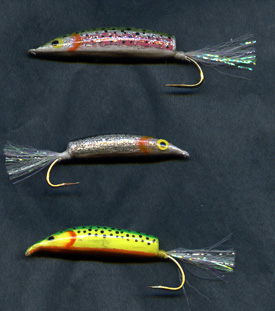 resurrected
as the Gilly Minnow by Louisville, Kentucky fly fisher Steve Gillenwater.
This fly rodder’s "Rapala" is fairly easy to cast and
has some incredible action in the water. They have developed a loyal
following in Minnesota for smallmouth in the Boundary Waters and are
equally effective on white bass, striped bass, hybrid ‘wipers’ and
largemouth bass across the Midwest. The
Gilly Minnow is available from Mad River Outfitters. (http://www.madriveroutfitters.com)
resurrected
as the Gilly Minnow by Louisville, Kentucky fly fisher Steve Gillenwater.
This fly rodder’s "Rapala" is fairly easy to cast and
has some incredible action in the water. They have developed a loyal
following in Minnesota for smallmouth in the Boundary Waters and are
equally effective on white bass, striped bass, hybrid ‘wipers’ and
largemouth bass across the Midwest. The
Gilly Minnow is available from Mad River Outfitters. (http://www.madriveroutfitters.com)
I posit that other, more traditional (if the word applies) flies should be categorized as fly rod plugs and not pure flies. Joe Blados’ Crease Fly, the Cypert Foil Minnow, and the Kreel Tackle Co. CK-Baitfish all have more in common with the hardware carried by spin fishers and revolving spool aficionados than they do with the delicate fur and feather creations normally associated with fly fishing. While some may debate their status as “flies”, all these lures are designed to be fished with a fly rod and often are at their most effective when so presented. Sometimes they are effective to the exclusion of heavier baits cast on a pure monofilament leash. The long rod is nothing if not versatile. If you find your way to be as creative and versatile as our choice of tackle truly allows, I am sure you will see your success on the water increase dramatically!